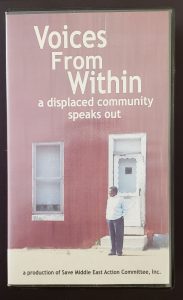Community organizers, activists, advocates, volunteers, and nonprofit organizations play a key role in the history of Baltimore City. Though the city has changed over time, these community groups and leaders advocate for the people living in the neighborhoods and communities that are affected by any changes. If you do a quick Internet search for “community organizing,” you’ll easily find a number of definitions and websites discussing the work of organizers and community organizations. There’s a lot to learn about this important work!
In general, community organizing involves the planned and coordinated efforts of community or neighborhood members and groups working towards a common goal or mission. These groups often work to improve a community’s living conditions, health, education, and other issues. In Baltimore, community organizers, groups, and nonprofits work on social justice efforts related to health, education, environmental issues, eminent domain and development/construction in neighborhoods, crime, and other issues.

The UB Special Collections & Archives holds many collections documenting the work of community organizers, grass-roots organizations, and nonprofits. Check out our recent blog post for a list of some of the collections documenting community organizers, nonprofits, and their work in the archives here! The Betty Garman Robinson Papers are a re-processed archival collection that includes recently added materials documenting Ms. Robinson’s work as a community organizer in Baltimore. The collection work was completed in April 2019 and is now fully accessible for researchers! You can learn more about the collection by using the online finding aid here!
Betty Garman Robinson is a community organizer who has contributed to many different social justice groups, nonprofits, and community organizations in Baltimore and elsewhere throughout her life. In her college years, Robinson became involved the Civil Rights Movement and worked with organizations like the National Student Association. She also worked with the Student Nonviolent Coordinating Committee (SNCC) in Mississippi and Georgia during the early 1960s.
You can read more about Betty’s work with SNCC here!
And listen to an interview with her available in the Internet Archive here!
Ms. Robinson has been a community organizer with numerous groups in Baltimore including the Baltimore Algebra Project, United Workers, the Citizens Planning and Housing Association (CPHA), Save Middle East Action Committee (SMEAC), Northeast Good Neighbors (NEGN), the Clearing House for a Healthy Community (CHHC), and others since she moved to the city in the 1970s. In 2003, she was awarded an Open Society Institute Baltimore Community Fellowship to work with local community groups and to teach the history of community organizing in Baltimore in workshops and classes. As a part of the fellowship Robinson also provided community organizing workshops, and taught a course entitled “History and Vision of Baltimore Social Justice and Organizing” at the Sojourner Douglass College in 2005. The resources and materials for her course are also present in the Betty Garman Robinson Papers.

The Betty Garman Robinson Papers in the UB Special Collections & Archives contain organizational records, newspaper clippings, correspondence, reports, community organizing training manuals and resources, class and teaching materials, and other materials related to Robinson’s work with community groups and organizations. One organization well represented in the collection is the Save Middle East Action Committee (SMEAC). SMEAC was a community group that resisted eminent domain and residential displacement in East Baltimore related to the construction of the Johns Hopkins Biotech Park during the 1990s and early 2000s. The materials in the collection related to SMEAC offer a glimpse into the history of the group and its work in East Baltimore.
The Save Middle East Action Committee (SMEAC) was formed in response to the group, East Baltimore Development Inc. [EBDI], which planned to remove the existing residential community and replace it with a new biotech park. This article/book review provides valuable history about SMEAC, and explains that although SMEAC was unable to save the residential homes and community from destruction and displacement resulting from eminent domain, they were able to help some displaced residents. Community organizers largely aim to influence positive change for the groups they serve. These organizations in Baltimore also have the unique ability to directly help individual neighborhoods. SMEAC is one example of the influence and affect community organizers, nonprofits, and local groups can have in neighborhoods and communities.
Researchers interested in the history of community organizing in Baltimore or the work Betty Garman Robinson has contributed to various organizations in the city, will find the materials in this collection interesting.
If you would like to view and/or use the Betty Garmin Robinson Papers (or any other archival collections) for yourself, please contact the Special Collections & Archives to set up an appointment!
